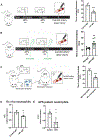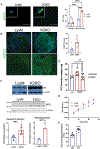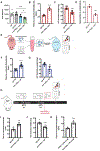A targetable pathway in neutrophils mitigates both arterial and venous thrombosis
- PMID: 36044595
- PMCID: PMC10318551
- DOI: 10.1126/scitranslmed.abj7465
A targetable pathway in neutrophils mitigates both arterial and venous thrombosis
Abstract
Arterial and venous thrombosis constitutes a major source of morbidity and mortality worldwide. Long considered as distinct entities, accumulating evidence indicates that arterial and venous thrombosis can occur in the same populations, suggesting that common mechanisms are likely operative. Although hyperactivation of the immune system is a common forerunner to the genesis of thrombotic events in both vascular systems, the key molecular control points remain poorly understood. Consequently, antithrombotic therapies targeting the immune system for therapeutics gain are lacking. Here, we show that neutrophils are key effectors of both arterial and venous thrombosis and can be targeted through immunoregulatory nanoparticles. Using antiphospholipid antibody syndrome (APS) as a model for arterial and venous thrombosis, we identified the transcription factor Krüppel-like factor 2 (KLF2) as a key regulator of neutrophil activation. Upon activation through genetic loss of KLF2 or administration of antiphospholipid antibodies, neutrophils clustered P-selectin glycoprotein ligand 1 (PSGL-1) by cortical actin remodeling, thereby increasing adhesion potential at sites of thrombosis. Targeting clustered PSGL-1 using nanoparticles attenuated neutrophil-mediated thrombosis in APS and KLF2 knockout models, illustrating the importance and feasibility of targeting activated neutrophils to prevent pathological thrombosis. Together, our results demonstrate a role for activated neutrophils in both arterial and venous thrombosis and identify key molecular events that serve as potential targets for therapeutics against diverse causes of immunothrombosis.
Figures







Comment in
-
Target neutrophils to treat thrombotic APS?Nat Rev Rheumatol. 2022 Dec;18(12):673. doi: 10.1038/s41584-022-00866-5. Nat Rev Rheumatol. 2022. PMID: 36309633 No abstract available.
Similar articles
-
Activated signature of antiphospholipid syndrome neutrophils reveals potential therapeutic target.JCI Insight. 2017 Sep 21;2(18):e93897. doi: 10.1172/jci.insight.93897. eCollection 2017 Sep 21. JCI Insight. 2017. PMID: 28931754 Free PMC article.
-
Surface Geometry of Cargo-less Gold Nanoparticles Is a Driving Force for Selective Targeting of Activated Neutrophils to Reduce Thrombosis in Antiphospholipid Syndrome.Nano Lett. 2023 Nov 8;23(21):9690-9696. doi: 10.1021/acs.nanolett.3c02075. Epub 2023 Oct 26. Nano Lett. 2023. PMID: 37884274 Free PMC article.
-
Release of neutrophil extracellular traps by neutrophils stimulated with antiphospholipid antibodies: a newly identified mechanism of thrombosis in the antiphospholipid syndrome.Arthritis Rheumatol. 2015 Nov;67(11):2990-3003. doi: 10.1002/art.39247. Arthritis Rheumatol. 2015. PMID: 26097119 Free PMC article.
-
Targeting thromboinflammation in antiphospholipid syndrome.J Thromb Haemost. 2023 Apr;21(4):744-757. doi: 10.1016/j.jtha.2022.12.002. Epub 2022 Dec 22. J Thromb Haemost. 2023. PMID: 36696191 Review.
-
Prevention of Recurrent Thrombosis in Antiphospholipid Syndrome: Different from the General Population?Curr Rheumatol Rep. 2016 May;18(5):26. doi: 10.1007/s11926-016-0573-0. Curr Rheumatol Rep. 2016. PMID: 27032789 Review.
Cited by
-
The Role of Neutrophil Extracellular Traps (NETs) in the Pathogenesis of Systemic Lupus Erythematosus and Antiphospholipid Syndrome.Int J Mol Sci. 2023 Sep 1;24(17):13581. doi: 10.3390/ijms241713581. Int J Mol Sci. 2023. PMID: 37686381 Free PMC article.
-
Forecasting the Future of Antiphospholipid Syndrome: Prospects and Challenges.Mo Med. 2023 Sep-Oct;120(5):359-366. Mo Med. 2023. PMID: 37841574 Free PMC article.
-
Platelet-Neutrophil Crosstalk in Thrombosis.Int J Mol Sci. 2023 Jan 9;24(2):1266. doi: 10.3390/ijms24021266. Int J Mol Sci. 2023. PMID: 36674781 Free PMC article. Review.
-
The role of platelets in immune-mediated inflammatory diseases.Nat Rev Immunol. 2023 Aug;23(8):495-510. doi: 10.1038/s41577-023-00834-4. Epub 2023 Jan 27. Nat Rev Immunol. 2023. PMID: 36707719 Free PMC article. Review.
-
Mapping Thrombosis Serum Markers by 1H-NMR Allied with Machine Learning Tools.Molecules. 2024 Dec 13;29(24):5895. doi: 10.3390/molecules29245895. Molecules. 2024. PMID: 39769984 Free PMC article.
References
-
- Aird WC, Phenotypic heterogeneity of the endothelium. Circ. Res 100, 174–190 (2007). - PubMed
-
- von Brühl ML, Stark K, Steinhart A, Chandraratne S, Konrad I, Lorenz M, Khandoga A, Tirniceriu A, Coletti R, Köllnberger M, Byrne RA, Laitinen I, Walch A, Brill A, Pfeiler S, Manukyan D, Braun S, Lange P, Riegger J, Ware J, Eckart A, Haidari S, Rudelius M, Schulz C, Echtler K, Brinkmann V, Schwaiger M, Preissner KT, Wagner DD, Mackman N, Engelmann B, Massberg S, Monocytes, neutrophils, and platelets cooperate to initiate and propagate venous thrombosis in mice in vivo. J. Exp. Med 209, 819–835 (2012). - PMC - PubMed
Publication types
MeSH terms
Substances
Grants and funding
LinkOut - more resources
Full Text Sources
Medical
Molecular Biology Databases
Miscellaneous

